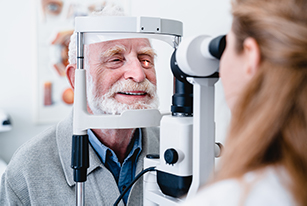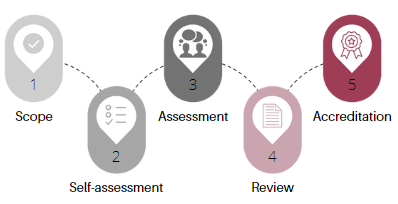Primary and Community Healthcare Accreditation
April 2022
Primary and Community Healthcare Accreditation is a hot topic at the moment!
Since the National Safety and Quality Primary and Community Healthcare Standards (NSQPCHS) were released by the Australian Commission on Safety and Quality in Health Care in late 2021, the incentive for primary and community health services to gain accreditation is increasing.
We regularly receive contact from primary and community healthcare service providers asking how they can get accredited – some providers are telling us that their funding bodies are requiring them to achieve accreditation, others have been eagerly awaiting a way to independently verify the quality of their services.
So, we’ve put together some helpful information, including the 5 Steps to Provisional Primary and Community Healthcare Accreditation for those who want to get started straight away.

What is Primary and Community Healthcare Accreditation?
Primary and Community Healthcare Accreditation is an independent confirmation that your health service meets the requirements of the National Safety and Quality Primary and Community Healthcare Standards (NSQPCHS) and has the evidence to prove it.
Find more information about the Primary and Community Healthcare Standards on the Commission’s website.
Who can get Primary and Community Healthcare Accreditation?
‘Primary and Community Care’ is a very broad category. The National Safety and Quality Commission defines the scope of the standards to include:
- Allied Health services including: audiology, chiropractic, dietetics, occupational therapy, optometry, osteopathy, physiotherapy, podiatry, radiology, social work and speech pathology.
- Community health services
- Medical Specialist services
- Community Mental Health services including counselling, psychology, psychiatry, clinical psychology, family and behavioural therapy.
- Private Dental Services (public dental practices are accredited to NSQHSS 2nd Edition)
 Certification to the NSQPCH Standards is voluntary but may be required under contractual or funding arrangements. Providers may choose to seek accreditation for a number of reasons including consumer confidence, to support grant and tender applications, or to gain a competitive advantage in their sector. Read more about the Benefits of Accreditation in Health Care.
Certification to the NSQPCH Standards is voluntary but may be required under contractual or funding arrangements. Providers may choose to seek accreditation for a number of reasons including consumer confidence, to support grant and tender applications, or to gain a competitive advantage in their sector. Read more about the Benefits of Accreditation in Health Care.
When can I get accreditation?
The Commission is expected to release the NSQPCHS Scheme Rules in mid-2022. Once these rules are released, full accreditation can occur.
Until then, providers who want to get started straight away (and who intend to transition to the Primary and Community Healthcare Standards, once available) can choose to apply for Provisional Accreditation by being assessed to a subset of actions, tailored to primary and community healthcare services, from the National Safety and Quality Health Service Standards (NSQHSS) Second Edition.
Once the Primary and Community Healthcare (NSQPCHS) Scheme rules are released, providers with Provisional Accreditation will need to meet a further six actions to be awarded full National Safety and Quality Primary and Community Healthcare (NSQPCH) Accreditation within 18 months of the release of the scheme rules.
If you are keen to get started straight away, read on to discover the five simple steps to Provisional Primary and Community Healthcare accreditation with HDAA.

5 Steps to Provisional Primary and Community Healthcare Accreditation
- Scope
We need a clear scope of your services to make sure everything you want to be on your certificate is assessed. This is an easy process of completing a form – we are more than happy to talk you through it!
- Self-Assessment
We will provide you with a self-assessment tool that is similar the one our assessors use, so you can easily identify where you are prepared and where you might need more evidence to meet the standards. Your HDAA Client Service Officer is available to answer any questions you have.
- Assessment
A planned onsite assessment with one or more of our assessors will then occur. Documentary evidence can be uploaded easily and securely via our Client Gateway for assessors to review onsite along with other assessment activities.
Our assessors will work collaboratively with you and let you know their findings throughout the assessment. At the end of the assessment, they will talk you though the overall results.
If any improvements are needed, they will let you know on the day and provide opportunities for you to ask any questions you may have or to correct any misunderstandings.
- Review
The Assessor/s written report is provided to you after it has been reviewed by an HDAA reviewer to ensure the quality of the report and its findings. Any improvement actions required will be set out in an easy-to-use plan within the report.
You will be provided with further time to address these improvement actions before a short final assessment (often remote or desktop) to verify that any gaps identified at the initial assessment have been satisfactorily responded to.
- Accreditation
Once all actions are met, HDAA will make a formal accreditation decision and communicate this to the Australian Commission on Safety and Quality in Health Care.
Congratulations – you are now provisionally accredited to the National Safety and Quality Primary and Community Healthcare Standards!

You can proudly display your certificate and use the HDAA Mark. When applying for that tender, grant or extra funding you can state you have Provisional National Safety and Quality Health Service Standards (NSQHSS) 2nd Edition accreditation and link to our certificate register as proof.
Once the Primary and Community Healthcare Standards are released you have 18 months to be assessed for another seven actions.
Are you ready to get provisional accreditation? Have questions or need more information?

